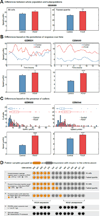Migration Phenotype of Brain-Cancer Cells Predicts Patient Outcomes
- PMID: 27292647
- PMCID: PMC5517094
- DOI: 10.1016/j.celrep.2016.05.042
Migration Phenotype of Brain-Cancer Cells Predicts Patient Outcomes
Abstract
Glioblastoma multiforme is a heterogeneous and infiltrative cancer with dismal prognosis. Studying the migratory behavior of tumor-derived cell populations can be informative, but it places a high premium on the precision of in vitro methods and the relevance of in vivo conditions. In particular, the analysis of 2D cell migration may not reflect invasion into 3D extracellular matrices in vivo. Here, we describe a method that allows time-resolved studies of primary cell migration with single-cell resolution on a fibrillar surface that closely mimics in vivo 3D migration. We used this platform to screen 14 patient-derived glioblastoma samples. We observed that the migratory phenotype of a subset of cells in response to platelet-derived growth factor was highly predictive of tumor location and recurrence in the clinic. Therefore, migratory phenotypic classifiers analyzed at the single-cell level in a patient-specific way can provide high diagnostic and prognostic value for invasive cancers.
Copyright © 2016 The Author(s). Published by Elsevier Inc. All rights reserved.
Figures




References
-
- Anton ES, Kreidberg JA, Rakic P. Distinct Functions of α3 and αV Integrin Receptors in Neuronal Migration and Laminar Organization of the Cerebral Cortex. Neuron. 1999;22:277–289. - PubMed
-
- Bellail AC, Hunter SB, Brat DJ, Tan C, Van Meir EG. Microregional extracellular matrix heterogeneity in brain modulates glioma cell invasion. The International Journal of Biochemistry & Cell Biology. 2004;36:1046–1069. - PubMed
-
- Chaichana KL, Jusue-Torres I, Navarro-Ramirez R, Raza SM, Pascual-Gallego M, Ibrahim A, Hernandez-Hermann M, Gomez L, Ye X, Weingart JD. Establishing percent resection and residual volume thresholds affecting survival and recurrence for patients with newly diagnosed intracranial glioblastoma. Neuro-Oncology. 2013a:not137. - PMC - PubMed
Publication types
MeSH terms
Substances
Grants and funding
LinkOut - more resources
Full Text Sources
Other Literature Sources
Medical

